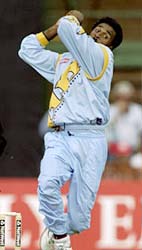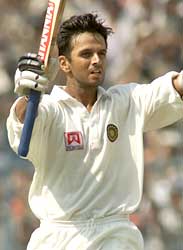India play safe yet again
Prem Panicker
Among other things, a convent education gives you a nodding acquaintanceship with stories out of the Bible - and one that has kind of stuck in my head was the parable of the talents.
I am a bit shy of the details but as I recall it, a king sent his three sons out into the world with X amount of talents - as metaphor for money of the realm -- apiece. One came back with his pockets empty, the second came back having carefully conserved what he had, and the third came back with his talents multiplied manifold.
Guess which of the three succeeded in life?
Now guess which of the three the Indian Test team reminds you of?
There is a certain sense of déjà vu to watching India on day one of a Test - especially with the ball. For some reason, we start off well, then inevitably run out of steam, and let the opposition out of the hole - I mean, how many times have we had a side 70-something for three or four and then let them climb back into the game, and put up a huge score?
 So, why? Two reasons are immediately obvious - we do not have strike bowlers with the power and stamina to blow teams away. Secondly, the bowlers we have do not possess mental strength and consistency - thus, it is almost inevitable that if a Srinath fires his partner will not; that if a Nehra and Zahir click then Agarkar at first change will not, and so on. (A third reason is that it made little sense to go in with three seamers on an absolutely flat track - but let us leave that lie for now).
So, why? Two reasons are immediately obvious - we do not have strike bowlers with the power and stamina to blow teams away. Secondly, the bowlers we have do not possess mental strength and consistency - thus, it is almost inevitable that if a Srinath fires his partner will not; that if a Nehra and Zahir click then Agarkar at first change will not, and so on. (A third reason is that it made little sense to go in with three seamers on an absolutely flat track - but let us leave that lie for now).
None of this is new to our cricket. And yet, contemporary captains and `think tanks' appear not to have factored this aspect of our bowling into its thinking. Incidentally, neither the malaise, nor this article, is exclusively to do with our current captain - surely none of us have forgotten our last tour of Australia, when we had the home team on the mat at lunch on day one, at 70-something for four and the two not outs struggling, before then captain Sachin Tendulkar famously started the second session with Sourav Ganguly and allowed the under-pressure batsmen to settle?
The problem is clear - and if you think about it for a moment, so is the solution. Since we do not have four regular bowlers capable of posing consistent problems, we have to make the best of all our resources. And in this connection, it is amazing that in the England first innings, it took 70 overs before it occurred to someone that Virender Sehwag could bowl.
As it turned out, the change - and the sudden introduction of a non-regular - produced the breakthrough.
At the end of it all, the England innings lasted 142 overs - and just 13 of them were by the non-regulars. Seamers who couldn't do much on the deck, and a spinner who could at best keep it straight, trundled for over after over, session after session - permitting the batsmen to settle into auto-pilot mode.
And yet, we have in the side a VVS Laxman, who bowls off spin with a very high arm action and keeps it very full and tight. And a Sachin Tendulkar who turns the ball almost square, leg or off as the mood takes him. When you add Ganguly and Sehwag to that mix, that is four non-regular bowling options, each presenting different questions to the batsmen.
Mix them in with the four regular bowlers, and you have multiple benefits - any time a batsman or a pair look like they are settling down, you bring in a non-regular for a quick spell just to change things around, to keep the batsman from settling. And, as you see happen time and again, a sudden introduction of a non-regular bowler often produces an unexpected breakthrough.
Secondly, four non-regulars bowling, say, 20 overs with every new ball (that is, 20 out of 80) is that much less strain on the regulars - giving the option to the captain of resting them more, and bringing them in for short, sharp bursts in swift rotation.
If we don't use our resources to optimum, hey, we deserve what we get. And what we got was 78/3 at one point; 357/7 when Hussain, last of the recognized batsmen, left; and 487 at the end of all the mayhem.

And talking of wasted `talents' - check out Rahul Dravid's knock. To give it context, Jaffer had gone early. A number three coming in and playing cautiously at the outset would have been understandable.
Instead, the Indian vice captain gets off the blocks like a startled hare, and outscores Sehwag. Once the latter joins the party, the opening bowlers - and Ashley Giles - are history. And Hussain has a huge problem on his hands.
And then - a sudden, inexplicable freeze. At least at one end.
Having gotten to 20 off just 24 deliveries, Dravid ends the day 33 off 114 - that is, he adds a further 13 runs off 90 deliveries. To put that innings - and the bowling and pitch - in perspective, Sehwag without taking any chances or indulging in needless slogging, coasts to 84 off just 97 balls without working up a sweat.
No one expects a Dravid to bat like a Sehwag - just as no one expects a Sehwag to bat like a Dravid. But look at the anatomy of Dravid's innings - 114 deliveries faced, 98 of which are dot balls, against just 9 singles.
At the other end a Sehwag - supposedly a four or nothing stroke player - actually has 18 singles out of 97 balls faced, besides 7 twos (two twos for Dravid) and two threes.
Given that the track was flat, and the bowling helpless, the need really was for India to put the boot in - and Dravid's contribution to that exercise would ideally have been a more rapid strike rotation. The overall goal would have been to go in at stumps having knocked a big hole in the total - and in the process, sent out the signal to the home side that this Indian team was capable of tearing England's apology for a bowling attack apart.
In that context, imagine the score at close if Dravid had taken a bit more pains to stroke singles around - say 15, 20 more of them (surely it is not too much to expect 20 singles off 97 deliveries?).
Imagine, too, the impact on the bowlers of that kind of strike rotation - constant pressure, no opportunity for any bowler to settle into any kind of line and length, ergo more bad deliveries.
Once England put 487 on the board, India would typically have figured, uh oh, this one is a draw.
So, just for fun, pretend it is Australia playing England. Stretch your imagination way beyond breaking point and figure that the Australian bowlers actually allowed England to pull away to 480-plus after being 70-something for three.
What could the Aussie calculation have been, given that they always look to play for a win?
Could it be something like this - that besides the 37 overs to be bowled on day two, there are still 270 overs (90 per day over three days) left in the game. That if the batting side set itself the goal of going after the bowling on day two with the intention of ending the day on somewhere around 150-170, and then set itself the task of batting at around 3.5 to 4 runs per over - eminently doable on this track against this attack - over another 150 overs, it would have, god help us all, something close to 800 on the board.
Judged by their recent play, this is the kind of thinking the Australians would have brought to this situation.
And that would mean the home side coming in for its second innings knowing that there was no way to win - and having to bat to save the Test. And no matter how docile the track or how apathetic the bowling, batting to save a Test brings its own pressures - ask the Aussies themselves, with reference to the Calcutta Test.
Given that scenario, who knows what could happen? You for sure cannot lose. And you just could win. Isn't that the whole point - to keep an eye on that half chance, and try to seize it at the smallest opportunity?
The argument against this will be that the scenario is entirely unrealistic - at least, as far as the Indian team is concerned. Why, exactly? Break that up into bite sized pieces - is it unrealistic, on the kind of track in use here, to expect a team comprising Dravid, Sachin, Ganguly and Laxman - repeatedly touted as among the top batsmen in the world -- to bat 90 overs for 360 runs? A further 60 overs for 240 runs (Remember that even with Dravid snowballing, 130 runs came off just 36 overs)?
I'm not saying - or even dreaming - that any of this will happen. Merely suggesting that it is this kind of mindset that fetches you victories. Instead, we appear intent on trying to `save' the Test.
Thank god at least one player had the sense to play the ball and the conditions - as opposed to going out with preconceived notions of how a Test batsman should play.
One final point about days one and two - what was the point of sending Ashish Nehra out as night-watchman? Even assuming he had survived, we would then have gone out on day three morning - when the imperative would have been to seize the initiative before the bowlers settled -- with Dravid stonewalling at one end, and Nehra scratching around at the other.
More Columns
Mail Prem Panicker